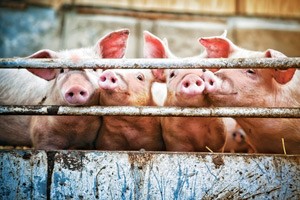Farmer, researchers offer insight into propane’s use in swine houses

According to USDA, more than 60 million hogs and pigs are bred and raised in the United States at any given time. Photo: iStock.com/t-lorien
Nearly one in three hogs and pigs in the United States is bred and raised in Iowa. That’s more than 40 million hogs and pigs produced in Iowa alone each year, according to the U.S. Department of Agriculture’s (USDA) latest Quarterly Hogs and Pigs Report.
And, considering six months are typically needed to feed out a pig, more than 20 million pigs reside in Iowa at any given time, says Jay Harmon, interim director of the Iowa Pork Industry Center at Iowa State University.
“There are only 3 million people in the state, so every person has about seven pigs,” Harmon says.
Iowa, like most states that breed and raise hogs, gets cold in the winter. And hogs and pigs need heat, at least while in their early developmental months, to survive and become marketable animals, Harmon says.
Their need is one of the many opportunities some propane retailers have to deliver fuel to farms. The opportunity is great, too, based on knowledge Harmon shared and USDA’s data.
According to Harmon, a wean-to-finish barn requires about 2 gallons of propane per year per pig space.
“In other words, if a barn holds 1,000 pigs, 2,000 gallons would be a good goal,” he says. “There are farmers who probably use 3 gallons [per pig space] and some who use 1.5 gallons, but 2 gallons is a good goal in a wean-to-finish barn.”
Based on Harmon’s logic, if data from USDA’s latest Quarterly Hogs and Pigs Report is projected outward for a full year, more than 130 million hogs and pigs are produced in the United States in a 12-month period.
“They’re not all produced in wean-to-finish barns, but if they were and we had 20 million pigs being fed, that means at 2 gallons [per pig space], that’s 40 million gallons of propane that could be used just for swine production in wean-to-finish barns [in Iowa].”
Nationwide, that would equate to 260 million gallons of propane use. Swine house heating isn’t necessary year-round, of course, and propane isn’t the only fuel used to heat hogs and pigs. But propane is the dominant fuel for this application, says Larry Jacobson, a professor and extension engineer on the University of Minnesota’s Swine Extension team.
“There is a big need for young animals to certainly maintain above-freezing temperatures and preferably more comfortable temperatures,” Jacobson says. “There is a need for supplemental heat in buildings, and propane is basically the first choice.”
Technology’s trajectory
Propane is the fuel of choice for Jeff Schwab, a southwest Ohio farmer who operates Schwab Family Farms. Schwab has more than 25 years of experience heating swine houses with propane. He estimates his three farms consume 30,000 gallons of propane each winter to heat the buildings.
“When we first had these farms, we had oil-fired furnaces,” Schwab says. “It worked fine, but it wasn’t really dependable. We switched to LP [gas] probably 25 years ago.”
Schwab has experience with several swine house heaters. He’s developed preferences over the years.
“We’ve switched everything the last few years to L.B. White’s,” Schwab says. “That’s the only brand we use now. We have fewer problems with them breaking down.”
Schwab says he has 50 furnaces across 20 barns on his three farms. Some of his L.B. White-made furnaces are 20 years old.
“I think it’s a better manufacturer to start with,” Schwab says of L.B. White. “I think it’s just a simpler design the way they do theirs. We use a lot of their Classic brand, which is going back to a blower and gas valve. It’s pretty simple. It has a pilot light ignition.”
Infrared heaters are another heating option for animal houses, says John Wortman, president and CEO of Detroit Radiant Products.
“A majority of live production facilities, when possible, have switched over to infrared systems,” Wortman says. “The reason is you have one less method of heat transfer, and this results in energy savings.”
According to Wortman, infrared heat provides a more comfortable and cleaner environment for animals. Wortman says fuel efficiency has improved among infrared heaters, as well.
According to Chris Smith, L.B. White’s marketing manager, fuel efficiency is the next frontier for propane heaters.
“We are always thinking about the next step,” Smith says. “We try to maximize our efficiencies and put the best product out there. We look at natural gas and propane as equals when we’re creating products. We have come out with new technology to help customers save fuel, like Smart Sense technology that modulates and keeps room temperature at a steady rate.”
















